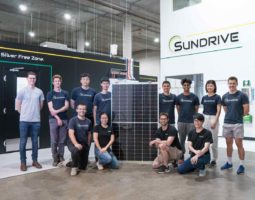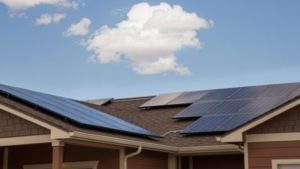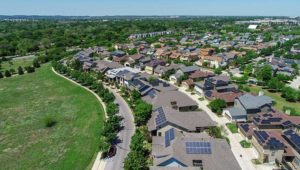Japanese construction company Sekisui Heim deployed the droids in a recent television ad promoting its “Smart Power Station”–branded net zero houses.
Though it probably paid a pretty penny to draft C-3PO and R2-D2 as spokesdroids, it will have been a manageable expense: not only is parent company Sekisui Chemical a sprawling 20,000-employee conglomerate, but Sekisui Heim itself has a Guinness Book of World Records entry for having built the most solar PV–equipped houses in the world, with 160,000.
The chart below – excerpted from its 2014 CSR report – only covers construction through 2013, but shows that Sekisui has been in this for the long haul, having built its first solar-equipped homes when Japan began ramping up photovoltaic production in the late 1990s. (Those interested in the Japanese government’s policy support over time, can refer to this webpagefrom the IEA.)
The company’s near-net-zero efforts date back to 2003, with its introduction of feed-in-tariff-assisted “net-zero utility cost” homes. Its current “Smart Power Station” residences are designed to be net electricity generators.
To be fair, this is easier to achieve in Japan than most other developed countries, given the high solar insolation (an average of 4.5 kWh per square metre per day) and residents’ relative electric thrift: Japanese households use an average of 15 kWh of electricity per day, in line with European countries, and about half the North American average. (Big, big tip of the hat to Shrink That Footprint for compiling the data.)
But solar panels are only half of the Smart Power Station equation; the homes aim to give their owners partial electric autonomy by combining solar with lithium-ion battery storage, as shown in the screen grab from the 0:19 mark of the ad. Given that the battery powers a hairdryer at around 0:22, we can infer that either the battery can discharge faster than a Tesla Powerwall, or the marketing agency doesn’t appreciate just how much power those things draw!

A Home Energy Management System (or “HEMS”) and the company’s proprietary “Kaiteki Airy” Energy Recovery Ventilation unit round out the product, with the latter using the heat and humidity (or lack thereof) of indoor air to pre-condition fresh air brought into the house.
The human side of residential solar…
In light of Zachary’s commitment to highlight the human side to cleantech, I’ll note in passing that I first saw the Sekisui ad on TV while visiting in-laws in Japan, whose rooftop solar array produces about one and a half times their annual electric consumption, which includes electric heating and hot water.
It was simultaneously mortifying and encouraging that my pragmatic relatives beat me to net-zero house status.
It was mortifying because I’m an aspirational environmentalist who forgoes red meat, chose cleantech over crude with his Canadian chemical engineering degree, and even convinced his infinitely-patient wife that the family should buy a plug-in hybrid electric vehicle, despite not being able to charge at home or work! (Thanks to local infrastructure, about 40% of our miles have been electric thus far.)
I first learned about net-zero homes in 2007, and determined that we’d one day live in one, but alas, the price of housing in Vancouver kept rising faster than our savings. (An added challenge is that much of the Pacific Northwest is a rainforest, so a lot of solar panels are needed to generate one North American household’s worth of electricity.)
But it was simultaneously encouraging because my relatives didn’t go net-zero for any idealistic reasons; theirs was largely a wallet-driven decision. The feed-in tariff they receive is good for 10 years – long enough to pay the system off – at which point they’ll enjoy net savings. If at that point utilities don’t fully value their solar electrons, battery storage will have become cheap enough to make purchasing one worthwhile.
…and the economic side
And while market purists may frown at cleantech subsidies in the abstract, it’s worth reinforcing that we live in a real-and-messy world, where fossil fuels impose $10 million of social costs on societies every minute while flooring the gas on the warming that will worsen those costs by the year.
Besides which, the very notion that societies shouldn’t invest in what they perceive benefits their future lest they guess wrong is dumbfoundingly short-sighted. Taken to its illogical conclusion, this reasoning suggests that the adults who constitute our societies shouldn’t invest in their children – the future – lest the money be wasted.
One imagines that a consensus of, oh, let’s say 97% of market purists would agree that investing in one’s children is justified!


Source: CleanTechnica. Reproduced with permission.











